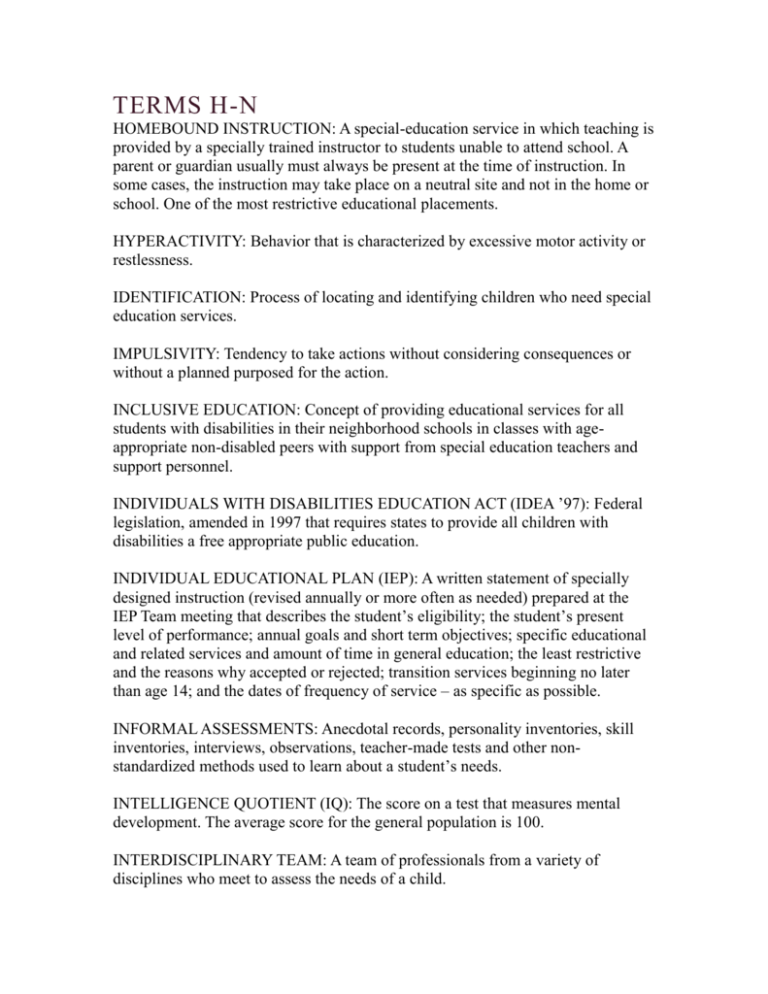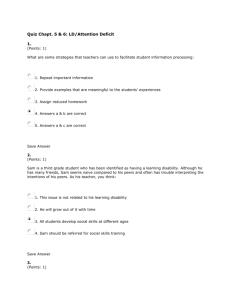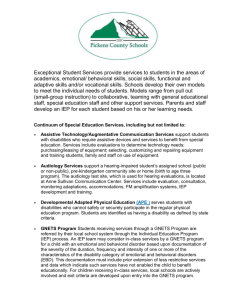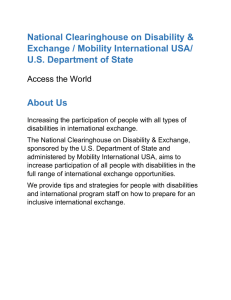Terms H-N - Wyckoff School District
advertisement

TERMS H-N HOMEBOUND INSTRUCTION: A special-education service in which teaching is provided by a specially trained instructor to students unable to attend school. A parent or guardian usually must always be present at the time of instruction. In some cases, the instruction may take place on a neutral site and not in the home or school. One of the most restrictive educational placements. HYPERACTIVITY: Behavior that is characterized by excessive motor activity or restlessness. IDENTIFICATION: Process of locating and identifying children who need special education services. IMPULSIVITY: Tendency to take actions without considering consequences or without a planned purposed for the action. INCLUSIVE EDUCATION: Concept of providing educational services for all students with disabilities in their neighborhood schools in classes with ageappropriate non-disabled peers with support from special education teachers and support personnel. INDIVIDUALS WITH DISABILITIES EDUCATION ACT (IDEA ’97): Federal legislation, amended in 1997 that requires states to provide all children with disabilities a free appropriate public education. INDIVIDUAL EDUCATIONAL PLAN (IEP): A written statement of specially designed instruction (revised annually or more often as needed) prepared at the IEP Team meeting that describes the student’s eligibility; the student’s present level of performance; annual goals and short term objectives; specific educational and related services and amount of time in general education; the least restrictive and the reasons why accepted or rejected; transition services beginning no later than age 14; and the dates of frequency of service – as specific as possible. INFORMAL ASSESSMENTS: Anecdotal records, personality inventories, skill inventories, interviews, observations, teacher-made tests and other nonstandardized methods used to learn about a student’s needs. INTELLIGENCE QUOTIENT (IQ): The score on a test that measures mental development. The average score for the general population is 100. INTERDISCIPLINARY TEAM: A team of professionals from a variety of disciplines who meet to assess the needs of a child. INTERVENTION: Preventive, remedial, compensatory, or survival services given to an individual in need. KINESTHESIS: Sensation of movement arising from one’s muscles, joints and inner ears. LEA – LOCAL EDUCATIONAL AGENCY: i.e., a local public school district. LEARNING DISABILTY: Refers to students with average or above average intelligence ability who experience a severe discrepancy between their ability and their achievement. LEAST-RESTRICTIVE ENVIRONMENT: The educational setting which allows a child to receive special education services while among the greatest number of peers who do not have disabilities. The general educational classroom is the preferred educational setting. LONG TERM MEMORY: Recall system within the brain that keeps information for longer than several minutes. LONG TERM SUSPENSION: Any suspension in exceeding 10 school days. LOW INCIDENCE DISABILITY: A disability that affects relatively few of the total number of children with disabilities who receives special services. MAINSTREAMING: The educational placement of a person in the setting that allows the most interaction with peers who do not have disabilities. Typically requires the special education student to perform all elements of the class required of general education students. MANIFESTATION DETERMINATION REVIEW: An IEP Team meeting called to decide whether a student’s misconduct was caused by the student’s disability. MEDIATION: An informal process in which an impartial facilitator tries to help parents and school districts resolve differences over student’s identification, programming or placement. MOBILITY INSTRUCTION: Integration of specific daily living skills into the educational program of a student with a disability to help the student navigate safely in the community. MOBILITY SPECIALIST: A professional with formal training who provides mobility training, including orientation, to blind individuals. MODELING: Imitation by a child of desired behaviors performed by peers or teachers. MODIFICATIONS: Substantial changes in what the student is expected to demonstrate; includes changes in instructional level, content, and performance criteria, may include changes in test form or format; includes alternate assessments. MULTIPLY DISABILED: Corresponds to “multiply handicapped” and “multiple disabilities,” and means the presence of two or more disabling conditions, the combination of which causes such severe educational needs that they cannot be accommodated in a program designed solely to address one of the impairments. Multiple disabilities includes cognitively impaired-blindness, cognitively impaired-orthopedic impairment, etc. The existence of two disabling conditions alone shall not serve as a basis for a classification of multiply disabled. Eligibility for speech-language services as defined in this section shall not be one of the disabling conditions for classification based on the definition of “multiply disabled.” Multiply disabled does not include deaf-blindness. MULTIDISCIPLINARY EVALUATION: The testing of a student by a group of professionals: psychologists, learning disability teacher consultants, social workers, speech/language therapists, etc. MULTISENSORY APPROACH: In connection with reading instruction, use of visual, auditory and tactile or kinesthetic pathways to present instructional content. NATIVE LANGUAGE: The primary language used by an individual. NEUROLOGICAL: Relating to the nervous system. NORM-REFERENCED TESTS: Tests that compare a child’s performance to the performance of others when using the same measure. For example, a child’s reading skills are compared to the scores by all other children his age, based on proven research.











